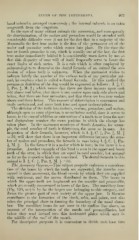Page 393 - My FlipBook
P. 393
TEETH OF THE VERTEBRATA. 403
basal tubercles arranged transversely ; the internal tubercle is an extra
outgrowth from the cinoulum.
In the case of many extinct animals the succession, and consequently
the discrimination, of the molars and premolars would be attended with
considerable difficulty were it not for the fact that in a majority of the
Mammalia the first true molar is the first of the permanent set of the
molar and premolar series which comes into place. By the time the
last or fourth premolar is cut, which is usually one of the last, the first
true molar immediately behind it is considerably worn down by use, so
that this disparity of wear will of itself frequently serve to locate the
exact limits of each series. It is a rule which is often employed by
palaeontologists to determine the dental formula of an animal the suc-
cession of whose teeth is unknown. When the anatomist wishes to
indicate briefly the number of the various teeth of any particular ani-
mal, he employs what is called a dental formula. By this method the
permanent dentition of the dog would be expressed as follows : I. |, C.
\, Pm. 1^, M. 1^ ; which means that there are three incisors upon each
side above and below, that there is one canine upon each side above and
below, that there are four ])remolars, and that there are two true molars
above and three below. This manner of abbreviation is convenient and
easily understood, and saves both time and space in descriptions.
The division of the teeth into incisors, canines, premolars, and molars,
although open to some objection, is nevertheless useful, since it serves to
locate, in the case of addition or subtraction of a tooth to or from the nor-
mal dijihyodont number, the exact position in which the change has
taken place. In the marmoset monkeys of South America, for exam-
ple, the total number of teeth is thirty-two, the same as in man. An
inspection of their formula, however, wdiich is I. |-, C. \, Pm. |, M. ^
= 32, will show that there is an important difference between the num-
ber of molars and premolars, the formula in man being I. C. \, Pm.
f,
f , M. f . In the former it is a molar vchicli is lost ; in the latter it is a
premolar. Another example of this kind is seen in the upper and lower
teeth of the otter, in which they are equal in total number, but unequal
as far as the respective kinds are concerned. The dental formula in this
animal is I. , C. \, Pm. M. l - 36.
f f^
The Accessory Organs.—This subject properly embraces a considera-
tion of the bones by which the teeth are supported, the muscles con-
cerned in their movement, the blood-vessels by which they are supplied
with nutriment, and the nerves distributed to them. The bones in
which the upper teeth are implanted are the maxillce and prem.nxill(je,
which are usually enumerated as bones of the face. The maxillary bone
(Fig. 195, mx) is by far the largest one belonging to this category, and
forms the greater part of each moiety of the upper jaw. It likewise
contributes to the formation of the cheek, orbit, and palate, and also
takes the principal share in forming the boundary of the nasal cham-
ber. The maxillary bones do not meet in the median line above, on
account of the interposition of the nasals and premaxillaries, but
below they send inward two thin horizontal plates which meet in
the middle of the roof of the mouth.
For descriptive purposes it is convenient to divide each bone into


